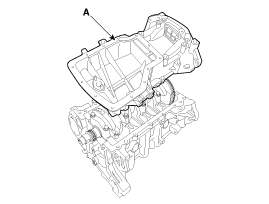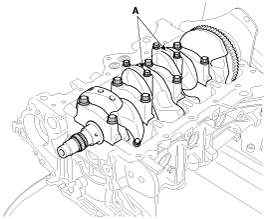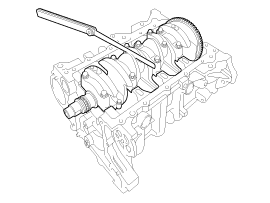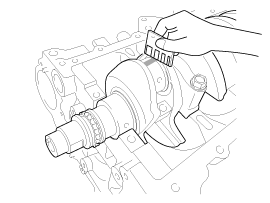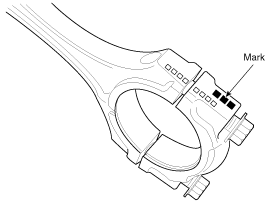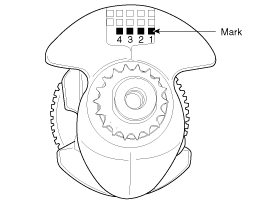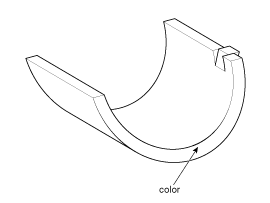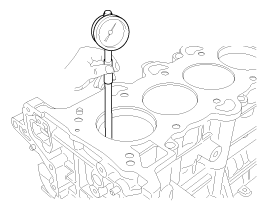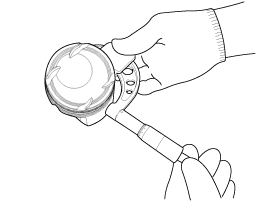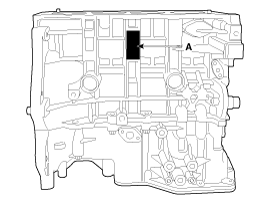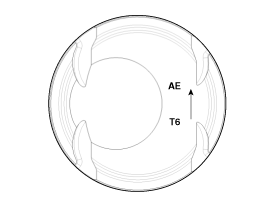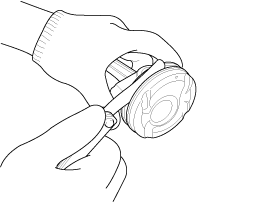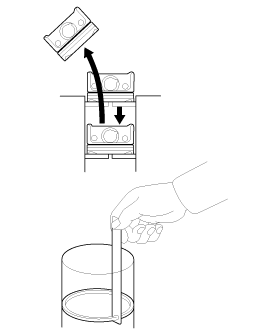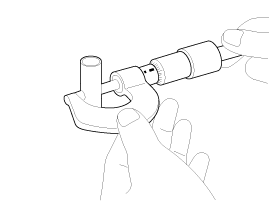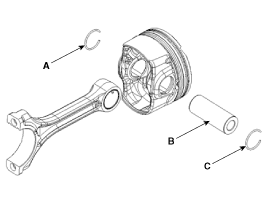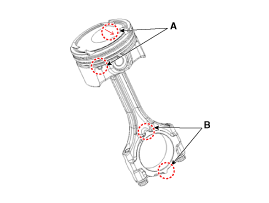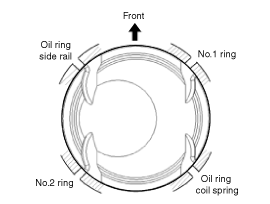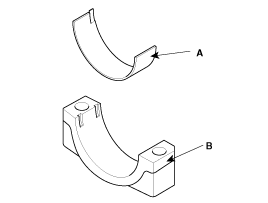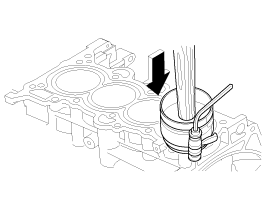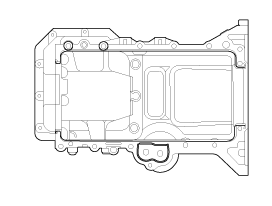Hyundai Kona: Cylinder Block / Piston and Connecting Rod Repair procedures
| Disassembly |
|
|
| 1. |
Remove the engine assembly from the vehicle.
(Refer to Engine and Transaxle Assembly - "Engine and Transaxle Assembly")
|
| 2. |
Remove the transaxle assembly from the engine assembly.
(Refer to DCT(Dual clutch Transmission) System - "DCT (Dual clutch Transmission)")
|
| 3. |
Remove the external damper flywheel (A).
(Refer to Cylinder block - "External Damper Flywheel")
|
| 4. |
Remove the rear oil seal.
(Refer to Cylinder Block - "Rear Oil Seal")
|
| 5. |
Install the engine to engine stand for disassembly.
|
| 6. |
Remove the intake manifold.
(Refer to Intake and Exhaust System - "Intake Manifold")
|
| 7. |
Remove the exhaust manifold.
(Refer to Intake and Exhaust System - "Exhaust Manifold")
|
| 8. |
Remove the timing chain.
(Refer to Timing System - "Timing Chain")
|
| 9. |
Remove the cylinder head assembly.
(Refer to Cylinder Head Assembly - "Cylinder Head")
|
| 10. |
Remove the oil pan and oil screen.
(Refer to Lubrication System - "Oil Pan")
|
| 11. |
Remove the oil cooler.
(Refer to Lubrication System - "Oil Cooler")
|
| 12. |
Remove the ladder frame (A).
|
| 13. |
Check the connecting rod side clearance.
|
| 14. |
Check the connecting rod bearing cap oil clearance.
|
| 15. |
Remove the piston and connecting rod assembly.
|
| 16. |
Check fit between piston and piston pin.
|
| 17. |
Disassemble the piston rings.
|
| 18. |
Remove the piston and connecting rod.
|
| Inspection |
| 1. |
Check the side clearance between piston and connecting rod.
Using filler gauge, measure the side clearance while moving the connecting
rod back and forth.
|
| 2. |
Check the connecting rod bearing oil clearance.
|
|||||||||||||||||||||||||||||||||||||||||||||||||||||||||||||||||||||||||||||||||||||||||||||||||||||||||||||
| 3. |
Check the connecting rod.
|
| 1. |
Clean the piston.
|
| 2. |
Check the piston-to-cylinder clearance by calculating the difference
between the cylinder bore inner diameter and the piston outer diameter.
|
| 3. |
Select the piston matching with cylinder bore class (match classification
mark).
|
| 1. |
Inspect the piston ring side clearance.
Using a feeler gauge, measure the clearance between new piston ring
and the wall of ring groove.
If the clearance is greater than maximum, replace the piston.
|
| 2. |
Inspect the piston ring end gap.
To measure the piston ring end gap, insert a piston ring into the cylinder
bore. Position the ring at right angles to the cylinder wall by gently
pressing it down with a piston. Measure the gap with a feeler gauge.
|
| 1. |
Measure the outer diameter of piston pin
|
| 2. |
Measure the piston pin-to-piston clearance.
|
| 3. |
Check the difference between the piston pin outer diameter and the connecting
rod small end inner diameter.
|
| Reassembly |
|
| 1. |
Assemble the piston and connecting rod.
|
| 2. |
Install the piston rings.
|
| 3. |
Install the connecting rod bearings.
|
| 4. |
Install the piston and connecting rod assembly .
|
| 5. |
Check the side clearance between piston and connecting rod.
|
| 6. |
Install the ladder frame.
|
| 7. |
Assemble the other parts in the reverse order of disassembly.
|
 Piston and Connecting Rod Components and components location
Piston and Connecting Rod Components and components location
Components
1. Piston ring
2. Piston
3. Connecting rod
4. Connecting rod upper bearing
5. Connecting rod lower bearing
6. Connecting rod bearing ...
 Crankshaft Components and components location
Crankshaft Components and components location
Components
1. Crankshaft
2. Crankshaft upper bearing
3. Crankshaft lower bearing
4. Thrust bearing
5. Main bearing cap
6. Crankshaft sproket
7. ...
Other information:
Hyundai Kona (OS) 2018-2025 Service Manual: Front Impact Sensor (FIS) Description and operation
Description
ŌĆó
The front impact sensors (FIS) are installed on the upper of the side
panel in Front End Module (FEM). They are remote sensors that detect
acceleration due to a collision at their mounting locations.
ŌĆó
The pri ...
Hyundai Kona (OS) 2018-2025 Service Manual: Receiver-Drier Repair procedures
Replacement
1.
Remove the condenser.
2.
Remove the cap (A) on the bottom of the condenser with a L wrench.
Tightening torque :
9.81 - 14.71 N.m (1.0 - 1.5 kgf.m, 7 ...



